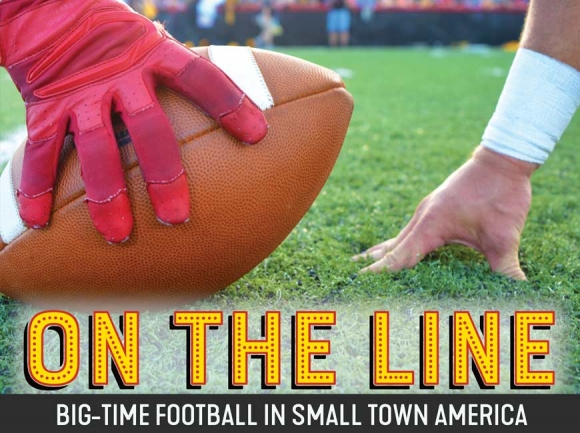THE MILL VS THE HILL: Small town high school football in the rural South

Doug’s in Clyde is a typical manifestation of a stereotypical small-town barbershop in the rural American South.
Its wooden walls are lined with knick-knacks, claptrap and faded family photos of people and places long gone. Three men stand behind three vintage teal and steel barber’s chairs, while three men sit in them. Others wait on red vinyl couches next to checkerboards beneath the watchful gaze of Andy Griffith and Floyd Lawson.
Between the intermittent jangle of the front door’s lanky chain and over the low, persistent buzz of clippers clipping, they all talk high school football. On this day, they all talk about a local rivalry that’s been called one of the greatest in the nation. On this night, that game will be played.

Tuscola High School’s new logo resembles the “T” from the University of Tennessee, but a helmet (right) hanging in Doug’s Barber Shop in Clyde still shows one from the mid-70s. Cory Vaillancourt photo.
Related Items
“Oh, it’ll never stop,” said barber David Bryson. “I mean, as long as there’s Tuscola and Pisgah, it’ll be here. It’s the Super Bowl of Haywood County.”
Rivalry games such as these are also a microcosm of the divisions in American society — it’s geography and class, and bluster and brass and a color that defines who you are. It’s memory farsighted, it’s houses divided, it’s new wounds on top of the scars.
But when the tiny mountain milltown plays the little tourist hilltown, it’s something else entirely that shines through.
“If the good Lord blessed me for some reason to become President of the United States there would be a Pisgah ‘P’ on Air Force One and it would land at Lake Logan Airstrip,” said Zeb Smathers. “I would not miss this game.”
Smathers is mayor of Canton, like his father was. He’s a graduate of Pisgah High School, like his father is. He also played on the football team, like his father did.
“I think my first memory of this game, I was in third grade. Nancy Moody was my teacher and she lived in Waynesville. I remember the class booing her because she was from Waynesville,” he said. “In third grade.”
The rivalry runs much deeper than its official 55-year history. In 1966, the county’s schools were integrated and consolidated, resulting in the creation of the red and black Pisgah Black Bears and the yellow and white Tuscola Mountaineers.
Those mascots were really just a reimagining of the Canton High School Black Bears and the Waynesville Township Mountaineers, their precursor schools — all of which were but institutionalized representations of rivalries hewn from these here hills centuries ago.

Pisgah Black Bears varsity quarterback Korey Griffith, a sophomore, drops back from center. Bill Killillay/Killillay.com photo
“I do have friends that did happen to go to high school at the wrong end of the county,” said Chuck Francis, 1974 Tuscola graduate and chairman of the Haywood Board of Education for the past 16 years. “And I call them ‘friends’ in a kind way.”
In this county of just 60,000 people, three of the four incorporated municipalities have populations of less than 5,000 residents. Mountainous terrain and a generous veining of creeks and rivers create physical barriers between them — they don’t bleed together like suburbia does, and have thus developed very distinct identities.
Canton, with its century-old paper mill at the center, fancies itself the blue-collar bastion of Haywood County, with its oldest-in-the-South Labor Day parade. With its long-time factories now long gone, Waynesville, twice the size and further west, is the county seat and features an upscale downtown shopping district, a thriving professional class and Tuscola’s hilltop campus.
“Really, you grow up and you just dislike Waynesville and Tuscola,” Smathers said. “Even when I was in high school, you didn’t associate. You didn’t date their girls, and if one of the girls from down here dated someone from up there, it became an issue quickly.”
Tubby Ferguson and his wife Stephanie didn’t start dating each other until college. She graduated from Pisgah the same year he graduated from Tuscola.
“We manage,” Tubby said. “It is kind of one of the first questions you ask somebody when you start taking interest in them. When you do find out, it becomes this kind of taboo thing, dating someone from across the county.”
Haywood’s household hostilities add an extra level of intensity to the rivalry, and Tubby admits it can be hard to endure year after year of snide comments made in passing across his own kitchen table.
“We joke about it, but it’s all in good fun,” he said, just before his wife interrupted him.
“All I have to say is, Pisgah’s won the past five years, so…”

About 13,000 people pack Pisgah Memorial Field in Canton last Friday to watch the nation’s best high school football rivalry. A Shot Above WNC photo
In the weeks leading up to the game, both towns are in a fever. Pizza joint marquees start the smack talk. Colors start popping up in unexpected places, like hardware stores and banks. Corporate stiffs sport neckties they haven’t worn in 11 months. Cheerleaders visit each high school’s feeder schools, which hold “spirit days.” Students cruise the streets with slogans soaped on their trucks and mascots hung in effigy just to harangue natives from the wrong end of the county.
“It does bleed over into business and politics,” said Francis. “You have to be careful, you have to walk that tightrope and not go too far in that rivalry, because you can make some folks mad — at least half the county.”
That habit can be hard to shake, as engrained as it is in the very fiber of Haywood’s being.
“I think the biggest change for me is that when you’re born and bred into this you dislike Waynesville 365 days a year,” said Smathers. “When I became an attorney, I realized I needed business from both ends of the county, so only one day a year do I hope the whole place burns to the ground.”
That day is today.
Since the Lyndon Johnson administration — Sept. 23, 1966, to be precise — the game has only been played in one of two stadiums, Canton’s Pisgah Memorial Stadium or Waynesville’s C.E. Weatherby Stadium.
Pisgah prevailed that day, as it would in the first seven such games. Then Tuscola won three in a row, including two on the road. A 13 to 13 tie at Pisgah on Nov. 22, 1974 set the pattern in reverse — Pisgah went on to win three in a row, including two on the road, before Tuscola took 10 straight.
That streak was snapped in 1988 and marked the beginning of an era where no team won more than two games in a row for over 20 years.
“I truly think it is the greatest high school rivalry in the state,” said Smathers. “I was blessed to go to both Duke and Carolina, and to sit in both those stadiums during basketball. This is our Duke-Carolina.”
The feud ranked second in a July Asheville Citizen-Times poll of best high school rivalries in Western North Carolina, but sports website greatamericanrivalry.com calls it one of the best in the nation.
Pisgah was for the 29th time the site for this year’s game, which drew more than 13,000 to the 7,000-seat stadium, tucked along the banks of the Pigeon River behind the old armory, smokestacks looming in the distance beyond green-dappled knobs.
It was warm, but not unseasonably so, with a still breeze following the little fluffy clouds lingering above.
Below the visitors’ stands, Mountaineers huddled in a stiflingly hot musty concrete bunker that had all the charm of a port-a-john, but less air circulation.

Moments before many of them start their final high school football game, Tuscola High School players gather for a pregame speech. Cory Vaillancourt photo
As first year head coach J.T. Postell called their names in turn, each assistant coach addressed the team, most of whom had their backs pinned to white walls. In succession they all talked about how they were born here, how they were lucky to be here and how they hoped to die here. They talked about their fathers, their sons.
Still perched at the cusp of adulthood, some players were sentimental and some were shaking — even before Postell laid out his platform.
“I think you know that this is more than just a game. It means a lot to everybody in here, and everybody in our community,” he said calmly, a large ineffectual fan humming comfortingly behind him.
“But I’m tired,” he said, his voice becoming more assertive, more defiant. “I’m sick and tired of losing to them!”
“Seniors, this is it!” It had now grown to a shout. “This is your last chance! Underclassmen! Make sure they go out winners! Because that’s what everybody in this room is! We are winners!” he boomed. “God dangit, I love you! Let’s…”
The end of Postell’s speech is, like many other ephemeral moments in the legacy of this partisan gridlock, lost to posterity; before he could finish, his crescendo got his team worked up into a deafening roar that reverberated around the room and will likewise long in the heads of kids who will tonight take off their helmets for the final time.

First-year Tuscola Coach J.T. postell fires up his team as they look on in rapt attention. Cory Vaillancourt photo
Once the skydivers — dragging a huge American flag — delivered the game ball to midfield, the mill’s whistle blew and kickoff ensued. Fired-up Tuscola jumped out to an early seven-nothing lead, but Pisgah came right back with a 76-yard strike just before the end of the first quarter.
After a Pisgah turnover deep in their own end, Postell’s team made a gutsy call to convert a red zone 4th and inches, but had to settle for three and nursed that 10-7 lead into halftime.
Pisgah came out and drove the length of the field to open the third quarter, found pay dirt but saw an extra point attempt fail, putting them up 13-10.
A Pisgah pick with 22 seconds left in the third left the Black Bears in good shape, however a bend-but-don’t-break Hill defense kept them out of the end zone, setting up a missed Mill field goal attempt.
The two sides then traded horses in what would become a fight for field position until Pisgah punched it in with six minutes left in the fourth, setting the score at what would become the final, 20 to 10.
Pisgah now leads the series 28 to 26, but the real winner may have been the guy who took home half of $42,731 because he had the winning ticket for the record-breaking 50-50 raffle. After donating back another $1,365.50 to the Pisgah Booster Club’s $21,365.50 haul, he walked with a check for $20,000.
America reveres tradition regardless of both relevance and obligation; much of a rivalry is so. You’re this or you’re that because your parents were or weren’t have’s or have-not’s. You’re not the same color as me. You’re not from here and you’re not from there but always to someone, you’re from the wrong end of the country. Or county.
That’s all changing, though. Here, at least.
“I’m being sincere about this — there is a special relationship happening in Haywood County right now where you have the communities and the county working together for economic development purposes and for recreation. I believe what is good for Waynesville is good for Canton. I sincerely believe they think the same thing,” Smathers said. “That is something that could not be said 15 or 20 years ago, even 10 years ago.”
Pisgah Democrat Smathers acknowledged people like Kirk Kirkpatrick (Tuscola Democrat, Haywood commission chair), Mike Sorrells (Tuscola Democrat, Haywood commissioner) and Brandon Rogers (Pisgah Republican, Haywood commissioner) as bipartisan collaborators helping move the county forward regardless of party, pedigree or provenance.
“It shows people can be very competitive, very enthusiastic, very passionate about their team, their cause and their beliefs, but we can get past that when the dust settles and get back to work,” he said. “That’s what people expect, not just in football, in politics as well.”
But like the Fergusons, Smathers sometimes has the toughest talks over his own kitchen table.
“My father-in-law is the head of the Republican Party,” said Smathers. “Him and I can sit down and find solutions. I think people get frustrated when they don’t see that in Raleigh and they don’t see that in D.C., but people can do that here in Haywood.”
Haywood County Schools Board Chair and Tuscola Dem Chuck Francis agrees that the rivalry won’t stand in the way, but with barber David Bryson he also agrees that the rivalry won’t go away, either.
“It can be divisive, but I can tell you one thing — whenever Pisgah is playing someone outside the county, the Tuscola fans are generally there pulling for them like I am,” said Francis. “And I like to pull for our team on the wrong end of the county just as much as Tuscola does — but only when they’re not playing each other.”









